Around the World
March/April 2023


-
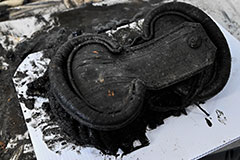 CANADA: Archaeologists have revisited the wreck of HMS Erebus, one of the ships of the ill-fated 1845 Franklin Expedition’s quest to find the Northwest Passage. They retrieved more than 275 artifacts from the captain’s steward’s pantry and 2 officers’ cabins, including a pair of lieutenant’s epaulettes in a bedside drawer. In the pantry, divers found fancy table settings as well as a leather-bound folio. Captain John Franklin and the expedition’s 128 crew members perished off King William Island during their search.
CANADA: Archaeologists have revisited the wreck of HMS Erebus, one of the ships of the ill-fated 1845 Franklin Expedition’s quest to find the Northwest Passage. They retrieved more than 275 artifacts from the captain’s steward’s pantry and 2 officers’ cabins, including a pair of lieutenant’s epaulettes in a bedside drawer. In the pantry, divers found fancy table settings as well as a leather-bound folio. Captain John Franklin and the expedition’s 128 crew members perished off King William Island during their search. -
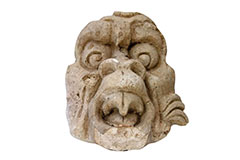 MEXICO: Mexican authorities revealed a collection of stone sculptures and stucco masks uncovered at the Maya site of Toniná. Most of the well-preserved objects were found within a building known as the House of the Re-Creation of the Universe. Dating to between A.D. 650 and 700, many of the objects represent themes connected with the earth or sky. One mask depicts the lord of the underworld, who is recognizable by his lack of a lower jaw, a common trait of inhabitants of the nether realm.
MEXICO: Mexican authorities revealed a collection of stone sculptures and stucco masks uncovered at the Maya site of Toniná. Most of the well-preserved objects were found within a building known as the House of the Re-Creation of the Universe. Dating to between A.D. 650 and 700, many of the objects represent themes connected with the earth or sky. One mask depicts the lord of the underworld, who is recognizable by his lack of a lower jaw, a common trait of inhabitants of the nether realm. -
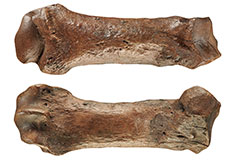 GERMANY: Although taboo for many today, humans have been wearing fur coats for at least 300,000 years. One of the earliest examples of hominins removing animal hides to use them as clothing comes from the site of Schöningen in Lower Saxony. Experts believe that cut marks on metatarsal and phalanx bones from the paws of extinct cave bears found there were not made during the normal butchering process, since there was little meat in the paws. Instead, they were likely made when the pelts were removed to be worn as protection against the harsh winter elements.
GERMANY: Although taboo for many today, humans have been wearing fur coats for at least 300,000 years. One of the earliest examples of hominins removing animal hides to use them as clothing comes from the site of Schöningen in Lower Saxony. Experts believe that cut marks on metatarsal and phalanx bones from the paws of extinct cave bears found there were not made during the normal butchering process, since there was little meat in the paws. Instead, they were likely made when the pelts were removed to be worn as protection against the harsh winter elements. -
 HUNGARY: Attila was called “the scourge of all lands,” but he was a particular nuisance to the Romans. As leader of the nomadic Eurasian Huns in the mid-5th century A.D., he frequently battled Rome. However, a new study relying on tree-ring analysis as well as historical and archaeological evidence suggests that money, bloodlust, and military glory may not have been Attila’s primary motivations. A series of severe droughts in the Huns’ homeland may have forced them into Roman territory to avoid starvation.
HUNGARY: Attila was called “the scourge of all lands,” but he was a particular nuisance to the Romans. As leader of the nomadic Eurasian Huns in the mid-5th century A.D., he frequently battled Rome. However, a new study relying on tree-ring analysis as well as historical and archaeological evidence suggests that money, bloodlust, and military glory may not have been Attila’s primary motivations. A series of severe droughts in the Huns’ homeland may have forced them into Roman territory to avoid starvation. -
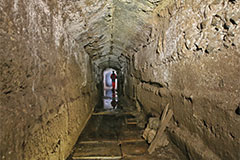 ITALY: They may not have enjoyed peanuts or Cracker Jack, but Roman spectators attending games in the Colosseum 1,900 years ago had plenty to snack on. An investigation of the sewer system that collected refuse and debris washed down from above indicates that fans munched on olives, figs, walnuts, and melons. They even enjoyed freshly cooked meat prepared on improvised braziers. Skeletal remains of beasts that died fighting for the Romans’ entertainment, such as tigers, bears, and leopards, were also found.
ITALY: They may not have enjoyed peanuts or Cracker Jack, but Roman spectators attending games in the Colosseum 1,900 years ago had plenty to snack on. An investigation of the sewer system that collected refuse and debris washed down from above indicates that fans munched on olives, figs, walnuts, and melons. They even enjoyed freshly cooked meat prepared on improvised braziers. Skeletal remains of beasts that died fighting for the Romans’ entertainment, such as tigers, bears, and leopards, were also found. -
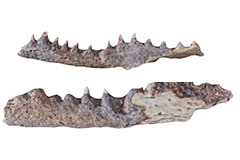 EGYPT: Two high-ranking Middle Kingdom (ca. 2030–1640 B.C.) Egyptian officials were laid to rest with crocodile heads to aid them in their journey to the afterlife. In western Thebes, 9 crocodile skulls were found wrapped in linen and entombed with 2 noblemen, one of whom was named Cheti. Although the mummified remains of complete crocodiles have previously been found in temples and animal cemeteries, this is the first time that non-mummified crocodile heads have been discovered buried along with people.
EGYPT: Two high-ranking Middle Kingdom (ca. 2030–1640 B.C.) Egyptian officials were laid to rest with crocodile heads to aid them in their journey to the afterlife. In western Thebes, 9 crocodile skulls were found wrapped in linen and entombed with 2 noblemen, one of whom was named Cheti. Although the mummified remains of complete crocodiles have previously been found in temples and animal cemeteries, this is the first time that non-mummified crocodile heads have been discovered buried along with people. -
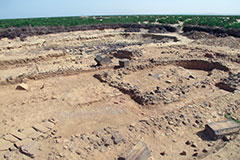 ERITREA: A pair of ancient churches first discovered more than a century ago was reexamined using modern excavation and dating techniques. The structures are located in the port of Adulis in territory that once belonged to the Kingdom of Aksum. The Aksumites controlled a powerful empire covering much of northeast Africa and southern Arabia during the 1st millennium A.D. In the 4th century A.D., the Aksumite king Ezana converted to Christianity. The 2 churches, now securely dating to between the 5th and 7th centuries A.D., are among the earliest Christian buildings in the region.
ERITREA: A pair of ancient churches first discovered more than a century ago was reexamined using modern excavation and dating techniques. The structures are located in the port of Adulis in territory that once belonged to the Kingdom of Aksum. The Aksumites controlled a powerful empire covering much of northeast Africa and southern Arabia during the 1st millennium A.D. In the 4th century A.D., the Aksumite king Ezana converted to Christianity. The 2 churches, now securely dating to between the 5th and 7th centuries A.D., are among the earliest Christian buildings in the region. -
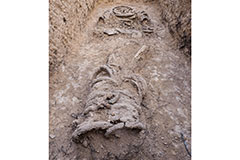 ISRAEL: A mysterious 1,500-year-old skeleton bound in heavy iron rings was unearthed at Khirbat el-Masani, north of Jerusalem. During the Byzantine era, the site was home to a monastery, a church, and an inn for religious pilgrims. Researchers believe that the deceased man practiced an extreme form of asceticism and that his seemingly tortured state was self-inflicted. The man was likely a monk who intentionally bound his neck, feet, and hands in chains as a way to attain salvation by denying himself simple sensory pleasures.
ISRAEL: A mysterious 1,500-year-old skeleton bound in heavy iron rings was unearthed at Khirbat el-Masani, north of Jerusalem. During the Byzantine era, the site was home to a monastery, a church, and an inn for religious pilgrims. Researchers believe that the deceased man practiced an extreme form of asceticism and that his seemingly tortured state was self-inflicted. The man was likely a monk who intentionally bound his neck, feet, and hands in chains as a way to attain salvation by denying himself simple sensory pleasures. -
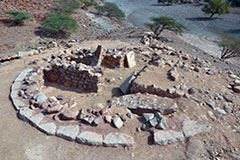 OMAN: Archaeologists unearthed a series of buildings belonging to the Umm al-Nar culture at the site of Dahwa that date to the mid-3rd millennium B.C. Amid the ruins was a tomb that contained a collection of silver jewelry, including a ring stamped with an image of an Indian bison. This was a common motif used in artwork of the Indus Valley, or Harappan, civilization. Analysis showed that the ring was likely made in Mesopotamia from silver sourced in Anatolia, highlighting the extensive trade networks cultivated by the area’s Bronze Age merchants.
OMAN: Archaeologists unearthed a series of buildings belonging to the Umm al-Nar culture at the site of Dahwa that date to the mid-3rd millennium B.C. Amid the ruins was a tomb that contained a collection of silver jewelry, including a ring stamped with an image of an Indian bison. This was a common motif used in artwork of the Indus Valley, or Harappan, civilization. Analysis showed that the ring was likely made in Mesopotamia from silver sourced in Anatolia, highlighting the extensive trade networks cultivated by the area’s Bronze Age merchants. -
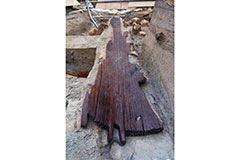 JAPAN: During the 1st millennium A.D., Japanese aristocrats were sometimes buried in sumptuous tombs alongside ritual statues known as haniwa. These were mostly made from terracotta, but on rare occasions were carved from wood. The largest known wooden haniwa was recently uncovered near the Minegazuka Kofun mound in Habikino. Dating to the 5th century A.D., the 11-foot-tall figure was recovered from a moat that surrounded the 315-foot-long monumental tomb.
JAPAN: During the 1st millennium A.D., Japanese aristocrats were sometimes buried in sumptuous tombs alongside ritual statues known as haniwa. These were mostly made from terracotta, but on rare occasions were carved from wood. The largest known wooden haniwa was recently uncovered near the Minegazuka Kofun mound in Habikino. Dating to the 5th century A.D., the 11-foot-tall figure was recovered from a moat that surrounded the 315-foot-long monumental tomb.
Advertisement
IN THIS ISSUE
Digs & Discoveries
Peru’s Lost Temple
Bird Brains
Standing Swords
Earliest Ayahuasca Trip
Early Medieval Elegance
L is for Lice
Weapons of Choice
Winter Light
Closely Knit
Mounds in the Family
Off the Grid
Around the World
Snacking in the Colosseum, Japanese tomb statue, Attila the Hun’s motives, 300,000-year-old fur coats, and Egyptian crocodiles in the afterlife
Artifact
Tunes for all time
Advertisement

Recent Issues
-
 May/June 2024
May/June 2024
-
 March/April 2024
March/April 2024
-
 January/February 2024
January/February 2024
-
 November/December 2023
November/December 2023
-
 September/October 2023
September/October 2023
-
 July/August 2023
July/August 2023
-
 May/June 2023
May/June 2023
-
 March/April 2023
March/April 2023
-
 January/February 2023
January/February 2023
-
 November/December 2022
November/December 2022
-
 September/October 2022
September/October 2022
-
 July/August 2022
July/August 2022
-
 May/June 2022
May/June 2022
-
 March/April 2022
March/April 2022
-
 January/February 2022
January/February 2022
-
 November/December 2021
November/December 2021
-
 September/October 2021
September/October 2021
-
 July/August 2021
July/August 2021
-
 May/June 2021
May/June 2021
-
 March/April 2021
March/April 2021
-
 January/February 2021
January/February 2021
-
 November/December 2020
November/December 2020
-
 September/October 2020
September/October 2020
-
 July/August 2020
July/August 2020
-
 May/June 2020
May/June 2020
-
 March/April 2020
March/April 2020
-
 January/February 2020
January/February 2020
-
 November/December 2019
November/December 2019
-
 September/October 2019
September/October 2019
-
 July/August 2019
July/August 2019
-
 May/June 2019
May/June 2019
-
 March/April 2019
March/April 2019
-
 January/February 2019
January/February 2019
-
 November/December 2018
November/December 2018
-
 September/October 2018
September/October 2018
-
 July/August 2018
July/August 2018
-
 May/June 2018
May/June 2018
-
 March/April 2018
March/April 2018
-
 January/February 2018
January/February 2018
-
 November/December 2017
November/December 2017
-
 September/October 2017
September/October 2017
-
 July/August 2017
July/August 2017
-
 May/June 2017
May/June 2017
-
 March/April 2017
March/April 2017
-
 January/February 2017
January/February 2017
-
 November/December 2016
November/December 2016
-
 September/October 2016
September/October 2016
-
 July/August 2016
July/August 2016
-
 May/June 2016
May/June 2016
-
 March/April 2016
March/April 2016
-
 January/February 2016
January/February 2016
-
 November/December 2015
November/December 2015
-
 September/October 2015
September/October 2015
-
 July/August 2015
July/August 2015
-
 May/June 2015
May/June 2015
-
 March/April 2015
March/April 2015
-
 January/February 2015
January/February 2015
-
 November/December 2014
November/December 2014
-
 September/October 2014
September/October 2014
-
 July/August 2014
July/August 2014
-
 May/June 2014
May/June 2014
-
 March/April 2014
March/April 2014
-
 January/February 2014
January/February 2014
-
 November/December 2013
November/December 2013
-
 September/October 2013
September/October 2013
-
 July/August 2013
July/August 2013
-
 May/June 2013
May/June 2013
-
 March/April 2013
March/April 2013
-
 January/February 2013
January/February 2013
-
 November/December 2012
November/December 2012
-
 Sep/Oct 2012
Sep/Oct 2012
-
 September/October 2012
September/October 2012
-
 July/August 2012
July/August 2012
-
 May/June 2012
May/June 2012
-
 March/April 2012
March/April 2012
-
 January/February 2012
January/February 2012
-
 November/December 2011
November/December 2011
-
 September/October 2011
September/October 2011
-
 July/August 2011
July/August 2011
-
 May/June 2011
May/June 2011
-
 March/April 2011
March/April 2011
-
 January/February 2011
January/February 2011
Advertisement






